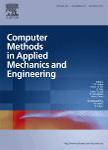版权所有:内蒙古大学图书馆 技术提供:维普资讯• 智图
内蒙古自治区呼和浩特市赛罕区大学西街235号 邮编: 010021

作者机构:RMIT Univ Ctr Innovat Struct & Mat Sch Engn Melbourne 3001 Australia Beihang Univ Inst Solid Mech Sch Aeronaut Sci & Engn Beijing 100191 Peoples R China
出 版 物:《COMPUTER METHODS IN APPLIED MECHANICS AND ENGINEERING》 (应用力学和工程技术中的计算机方法)
年 卷 期:2023年第416卷
核心收录:
学科分类:08[工学] 0701[理学-数学] 0801[工学-力学(可授工学、理学学位)]
基 金:China Scholarship Council Australian Research Council [FL190100014, DE200100887] National Natural Science Foundation of China
主 题:Topology optimization Structural complexity control Diverse and competitive structural designs Topological constraints
摘 要:Shape and topology optimization problems are usually associated with geometrical restrictions. Effective control of structural complexity during the optimization process is important for various considerations, e.g., functionality, manufacturability, and aesthetics. Most existing approaches characterize structural complexity as the number of cavities. However, for three-dimensional structures, the genus (i.e., the number of tunnels) should also be considered as an additional topological constraint. In this paper, a hole-filling method is integrated into the bi-directional evolutionary structural optimization (BESO) computational framework to control the number and size of existing cavities and tunnels during the form-finding process. In the hole-filling method, excess cavities are filled with solid material and excess tunnels are covered by building sheet-like patches. The minimum size of the truss-like components and the minimum thickness of the sheet-like components can be controlled separately. Several two-and three-dimensional compliance minimization problems are presented to demonstrate the effectiveness and potential applications of the proposed approach. The structural performances of the optimized structures with and without complexity control are compared and analyzed. The results show that the developed methodology can produce structurally efficient designs with controllable topologies. It is also demonstrated that the generation of sheet-like components can considerably increase the stiffness of the optimized structure. The proposed approach is capable of generating diverse and competitive designs for architects and engineers to achieve a fine balance between architectural novelty and structural efficiency.2023 The Author(s). Published by Elsevier B.V. This is an open access article under the CC BY-NC-ND license (http://***/licenses/by-nc-nd/4.0/).